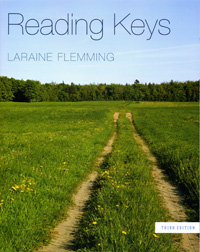| Chapter 1: |
Getting into a Textbook State of Mind |
| |
Learn How to Develop and Maintain Concentration
Preview Your Assignments
Use the Web for Background Knowledge
Read Strategically
Make Connections Between General and Specific Sentences
Making Marginal Notes
|
Learning the Language of Textbooks
Rounding Up the Keys
Ten Words for Your Textbook Vocabulary
Digging Deeper: Muscle Reading
Test 1: Reviewing the Key Points
Test 2: Developing Your Textbook Vocabulary
|
| Chapter 2: |
More on Words and Meanings |
| |
Using Context Clues
Breaking Words into Parts
Rounding Up the Keys
Digging Deeper: New Words Needed
Test 1: Reviewing the Key Points
Test 2: Using Context Clues
|
Test 3: Using Context Clues
Test 4: Using Word Parts and Context Clues
Test 5: Using Word Parts and Context Clues
Test 6: Using Word Parts and Context Clues
Test 7: Using Word Parts and Context Clues
|
| Chapter 3: |
From Topics to Main Ideas |
| |
What's the Topic?
What's the Main Idea?
Looking for Topic Sentences
Testing Your Topic Sentence
Rounding Up the Keys
Ten More Words for Your Textbook Vocabulary
Digging Deeper: Life Lessons from the Family Dog
|
Test 1: Identifying Topics and Topic Sentences
Test 2: Identifying Topics and Topic Sentences
Test 3: Identifying Topics and Topic Sentences
Test 4: Identifying Topics and Topic Sentences
Test 5: Identifying Topics and Topic Sentences
Test 6: Paraphrasing
Test 7: Developing Your Textbook Vocabulary
|
| Chapter 4: |
More on Topic Sentences |
| |
Topic Sentences in Third Place
Topic Sentences Closer to the Middle
Topic Sentences at the End
Get into the Habit of Paraphrasing
Rounding Up the Keys
Ten More Words for Your Textbook Vocabulary
Digging Deeper: Family Ties
|
Test 1: Reviewing the Key Points
Test 2: Recognizing Topic Sentences
Test 3: Recognizing Topic Sentences
Test 4: Recognizing Topic Sentences
Test 5: Recognizing Topic Sentences
Test 6: Developing Your Textbook Vocabulary
|
| Chapter 5: | Working Together: Topic Sentences and Supporting Details |
| |
The Function of Supporting Details
Major and Minor Details
Clues to Major Details in Topic Sentences
Topic Sentences, Transitions, and Major Details
Paraphrasing and Note-Taking
Rounding Up the Keys
Ten More Words for Your Textbook Vocabulary
Digging Deeper: Killer Waves
|
Test 1: Reviewing the Key Points
Test 2: Recognizing Supporting Details
Test 3: Recognizing Supporting Details
Test 4: Taking Notes on Paragraphs
Test 5: Understanding Major and Minor Details
Test 6: Recognizing Major and Minor Details
Test 7: Writing Summaries
Test 8: Developing Your Textbook Vocabulary
|
| Chapter 6: |
Drawing Inferences About Implied Main Ideas |
| |
Inferring Main Ideas
Effective and Ineffective Inferences
Allusions and Inferences
Rounding Up the Keys
Ten More Words for Your Textbook Vocabulary
Digging Deeper: Are Employers Making a Mistake Banning Facebook from the Workplace?
|
Test 1: Reviewing the Key Points
Test 2: Identifying the Implied Main Idea
Test 3: Identifying the Implied Main Idea
Test 4: Identifying the Implied Main Idea
Test 5: Inferring the Implied Main Idea
Test 6: Developing Your Textbook Vocabulary
|
| Chapter 7: |
Recognizing Patterns of Organization |
| |
Time Order
Simple Listing
Definition
Cause and Effect
Comparison and Contrast
Classification
Rounding Up the Keys
Ten More Words for Your Textbook Vocabulary
|
Digging Deeper: The Origins of Cinco de Mayo
Test 1: Reviewing the Key Points
Test 2: Patterns and Topic Sentences
Test 3: Recognizing Patterns of Organization
Test 4: Recognizing Patterns of Organization
Test 5: Recognizing Patterns of Organization
Test 6: Recognizing Patterns of Organization
Test 7: Developing a Textbook Vocabulary
|
| Chapter 8: |
Mixing and Matching Patterns |
| |
Pure Versus Mixed Patterns
Combining Patterns in Longer Readings
Common Combinations
Rounding Up the Keys
Ten More Words for Your Textbook Vocabulary
Digging Deeper: The Kursk’s Tragic End
Test 1: Reviewing the Key Points
|
Test 2: Recognizing Patterns in Paragraphs
Test 3: Recognizing Patterns in Paragraphs
Test 4: Recognizing Patterns in Paragraphs
Test 5: Recognizing Mixed Patterns in Longer Readings
Test 6: Recognizing Mixed Patterns in Longer Readings
Test 7: Recognizing Mixed Patterns in Longer Readings
Test 8: Developing Your Textbook Vocabulary
|
| Chapter 9: |
From Comprehension to Critical Reading |
| |
Informative Versus Persuasive Writing
When Bias Goes Overboard
Rounding Up the Key Points
Ten More Words for Your Textbook Vocabulary
Digging Deeper: Archbishop Oscar Romero
|
Test 1: Reviewing the Key Points
Test 2: Distinguishing Between Fact and Opinion
Test 3: Fact, Opinion, or Both
Test 4: Recognizing Tone and Purpose
Test 5: Evaluating Bias
Test 6: Developing Your Textbook Vocabulary
|
| Combining Your Skills |
| |
| Reading 1: |
The Seven-Day Antiprocrastination Plan
|
| Reading 2: |
Culture, Subcultures, and the Marketplace
|
| Reading 3: |
The Demise of Dating |
| Reading 4: |
Good Grief
|
| Reading 5: |
Backlash: Women Bullying Women in the Workplace
|
| Reading 6: |
Nonjudgmental and Critical Listening
|
| Reading 7: |
What Makes a Hero? |
| Reading 8: |
Raoul Wallenberg: A Lost Hero
|
| Reading 9: |
Online Therapy Clicks
|
| Reading 10: |
Checking the Stats
|
| Appendix: |
Dictionaries Online and in Print
|

